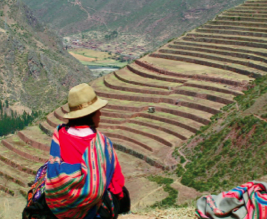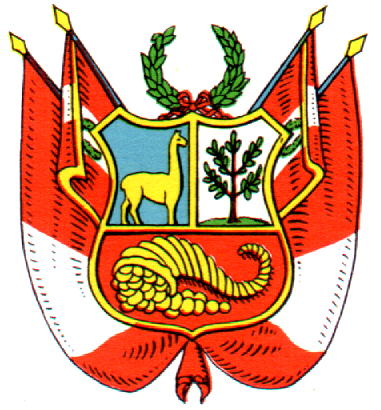Peru's Second National Communication - September 2010
Project Overview
The creation of a National Communication offers countries the opportunity to contribute with technically sound studies and information that can be used for designing mitigation and adaptation measures, and project proposals that can and will help increase their resilience to the impacts of climate change. Activities generally include: V&A assessments, Greenhouse Gas Inventory preparation, Mitigation Analysis or Education, and awareness raising activities.The ultimate goal is the integration of climate change considerations into relevant social, economic and environmental policies and actions.
The annual loss of nearly 261,000 hectares of forests, fueled by ever increasing migrant agriculture activities, is the major emission source for LULUCF activities totaling 55% of the Net CO2 emissions and 73% of the total CO2 national GHG emissions. Furthermore, the Andean glaciers melting pose significant risks to food, energy, water security and sustainability of the Pacific basin cities. Basic studies demonstrate that in the last 30 years, Peru has lost 22% of its glaciers’ surface, representing the loss of at least 7,000 million cubic meters of water.
Project Details
Peru is located in the Western Coast of South America (Pacific Fire Rim). This nation spans an area of 1,285,215 square km, being the third-largest country in South America after Brazil and Argentina, and is among the world's 20 largest nations. It is located at a seismic zone and consequently is affected by earthquakes. The territory of Peru has a highly uneven morphology, which greatly determines its highly diversified climate. The Andes range, which runs longitudinally from South to north of the country, is one of its most significant landmarks. It does not only originate three geographical regions known as coast (Chala), highlands (Andes) and rainforest (Amazonian), but also divides the air masses from the Pacific and the Atlantic Oceans hence acting as a barrier against the circulation of winds between the Pacific and Atlantic basins. This feature is one of the most important factors to climate heterogeneity making Peru’s climate extremely diverse and complex to monitor and model.
Peru holds the origin of the Great Amazon River and co-hosts with Brazil its path to the Atlantic Basin. This great river produces approximately 20 percent of all the fresh water coming from all the world’s rivers. Approximately 75% of Peruvian territory is located within the Amazonian Watershed. The country has the second largest Amazonian forest after Brazil, the longest Andean mountain chains, 71% of the world tropical glaciers and, 84 of the 117 life zones identified worldwide. Peru is one of the 16 Mega diverse Countries, holds its way over the sea up to 200 miles from the Peruvian coast and has territorial rights to an area of 60 million hectares in the Antarctic, which enrich its biodiversity and territorial assets.
Peru has approximately 28 million inhabitants mostly settled along the arid coastline. Peru is a nation of mixed ethnic origins. Throughout its history, Peru has been the meeting ground for different nations and cultures. The Spaniards joined the indigenous population 500 years ago. As a result of this encounter, and later enriched by the migration of African blacks, Asians and Europeans, Peruvian man emerged as the representative of a nation whose rich ethnic mix is one of its leading characteristics.
To date Peru’s GDP (measured in purchasing power parity) reaches US$155.3 billion, mostly fed by the revenues associated to its strong mining industry and high prices for copper, gold and zinc. However, this dependence on minerals and metals makes its economy very sensitive to fluctuations in world prices. This fact and a lack of infrastructure decelerate the general growth of trade and investment. After several years of volatility, the Peruvian economy grew by an average 4 percent per year during the period 2002-2004, with a stable exchange rate and low inflation. Risk premiums on Peruvian bonds on secondary markets reached historically low levels in late 2004, reflecting investor optimism regarding the government’s prudent fiscal policies and openness to trade and investment. Despite the strong macroeconomic performance, unemployment and poverty have stayed persistently high.
Hydroelectric energy is the main source of electricity of Peru, representing 85% of the total electricity produced in the country. However, the recent development of its natural gas fields is generating new energy options, revealing a need to guide and support the energy policy-making process to ensure its long-term sustainability.
Peru has been ranked third on the list of countries with more risks to climate hazards, after Bangladesh and Honduras. According to preliminary national climate change scenarios (PROCLIM, 2004), future climate change would exacerbate this condition. Statistics from the National Institute of Civil Defense (in charge of managing hazard impacts and disaster responses) show that emergencies due to natural hazards have increased about 650% in the last 10 years (1995-2004), and at least 72% of these hazards were climate related.
The annual loss of nearly 261,000 hectares of forests (National Institute of Natural Resources, INRENA, 2002), fueled by ever increasing migrant agriculture activities, is the major emission source for LULUCF activities totaling 55% of the Net CO2 emissions and 73% of the total CO2 national GHG emissions. Furthermore, the Andean glaciers melting pose significant risks to food, energy, water security and sustainability of the Pacific basin cities. Basic studies demonstrate that in the last 30 years, Peru has lost 22% of its glaciers’ surface, representing the loss of at least 7,000 million cubic meters of water.
Although there is no direct quotation to climate change into the CP/GFC/CCA UNDAF situation analysis, there are lines devoted to energy, environment and capacity strengthening areas. A quick look into GEF supported activities within Peru showed an important allocation of GEF support into a number of projects focused on specific topics, such as technical assistance to obtain bio- fuels and non-wood cellulose fiber, rural electrification projects, among others, with scope and benefits at the local level. To date, GEF activities in Peru have not included an overall assessment of policy options to mitigate GHG emissions from the energy and industry sides, nor the strategies for their possible implementation within Peru’s institutional context or the integration of climate change adaptation and mitigation factors into the sustainable development agenda of Peru. This proposal is structured in response to this gap, in line with the Strategic Priority of “Enabling Activities in support of National Communications for Non Annex I Parties of the Convention” within the GEF Operational Strategy for “Climate Change” and in line with the UNFCCC guidelines for Non Annex I National Communications (Decision 17/CP. 8).
Although Peru has gathered and generated information and has been developing capacities to deal with climate change through its First National Communication to the UNFCCC and the PROCLIM program, there is still insufficient information for decision making, coupled with lack of awareness of the issues, and inadequate institutional capacities to deal with climate change and comply with its UNFCCC commitments. Much progress has been achieved in terms of raising the technical capabilities of government institutions regarding diverse thematic areas of climate change. However, Peru still requires considerable effort to integrate and mature institutional know-how and responses to climate change. These facts prompt us to propose an enabling activity for the Second National Communication, which by building on the existing information and strengthening the ongoing capacity building activities, will be essential to the Peruvian strategy to incorporate climate change into the development and poverty reduction processes.
The fact that 52% of the population lives under the poverty line increases the country’s vulnerability conditions. Especially for poor populations, climate change threatens to exacerbate this situation.
On the road to development, all Peruvians do not go at the same pace. Strong differences in education, socioeconomic level, gender and geographical location jeopardize the synchronized progress of the whole society. In a society where the principle of "first come, first served" applies, the socioeconomic development gap along Peru can be enhanced through the differentiated exposure to climate change, therefore leaving the poor even further behind. Different socioeconomic groups and geographical areas of Peru have different exposure to Climate Change. This may prevent the timely achievement of, at least, two of the Millennium Development Goals: "Eradicate extreme poverty and hunger" and "Ensure environmental sustainability".
The ongoing development of Peru and the upcoming logging activities to be boosted by the Inter Oceanic Peru-Brazil highways menace any effort to mitigate much of Peru’s emissions. More than 55% of Peruvian GHG of the net CO2 emissions comes from LULUCF sector. This share could rise sharply if there is no GHG inventory management system in place to foresee or monitor the impact, in terms of emissions, of policies and programs implemented along the Peruvian Amazonian (the second largest after Brazil).
In light of the recent availability of natural gas resources, Peru has focused most of its recent efforts to materialize the Camisea Natural Gas project. While it is of common interest to count on a reliable energy supply, most political and government settings are not aware of the need to diversify Peruvian energy options including those representing climate friendly alternatives such as hydro, wind, geothermal and biomass sources. In this context, the threat to Peru is to base energy supply and usage decisions solely on short-term criteria without considering the long-term implications. This is exacerbated by the lack of long-term policies and planning capacities within the industry, transport, and forestry and, to a lesser degree, the energy sector.
The only agenda for most sectors across Peru is of a short-term nature. This poses the menace of allocating resources to issues or targets that in principle could be useful for the day-to-day needs of Peru, but do not necessarily reflect the real needs of Peru in terms of Climate Change. Much of the knowledge generated regarding the Peruvian response to Climate Change can be easily overlooked in the future. This know how is at risk of being excluded from the policy making decision process not only in Peru but in other countries where some of the Peruvian practices can shed light on how to proceed regarding Climate Change. The natural venue to disseminate this knowledge and information is the SNC.
Source: Peru, Second National Communication Project Document
Key Results and Outputs
- Sustainable development and the integration of climate change concerns into medium- and long-term planning
- Inventories of anthropogenic emissions by sources and removals by sinks of greenhouse gases
- Measures contributing to addressing climate change
- Research and systematic observation
- Climate change impacts, adaptation measures and response strategies
- Education, training and public awareness
Outcome 1: Adaptation Strategy for prioritized areas and sectors
- Output 1.1: Climate Change Scenarios at national level and 2 river basin level
- Output 1.2: Integrated V&A assessments in prioritized river basins and sectors that provide a representative sample of climate change impact and responses according to Peru’s diversity.
- Output 1.3: Determination of the relationship between climate change, glaciers retreat, and impacts on water availability in Peru
- Output 1.4: Proposal for the incorporation of climate variability and climate change variables into macroeconomic models, public budget allocation process and public investment system
- Output 1.5: Adaptation Strategy
Outcome 2: Development of a National GHG Inventory Management System
- Output 2.1: Perform an analysis on information, legal, capacity and technological constraints and needs of the inventory process considering the FNC and PROCLIM experiences.
- Output 2.2: Participative design of an inventory management system.
Outcome 3: Strategy to mitigate GHG emissions in the Energy, Industry, Transport and LULUCF sectors.
- Output 3.1: Assessment of options to mitigate GHG emissions in the Energy, Industry, Transport and LULUCF sectors.
- Output 3.2: Development of a Mitigation Strategy proposal for the Energy, Industry, Transport and LULUCF sectors.
- Output 3.3: Steps to be taken to mainstream the mitigation strategy proposal into national and sectoral policies.
Outcome 4: Description of Steps taken to integrate climate change and development
- Output 4.1: Develop dissemination and capacity building activities for relevant stakeholders and decision makers to evaluate, prioritize and support generated mitigation and adaptation strategy proposals.
- Output 4.2. Evaluation and development of indicators to assess the impact of the National Communication process in national policy, sectoral planning, and in the development agenda, such as poverty reduction policies and the Millennium Development goals
Outcome 5: Prioritized Analysis of Constraints, Gaps and Needs of a National Observation System and Climate Change Research.
- Output 5.1: Identification and prioritization of constraints, gaps and needs (technical, methodological, institutional and financial) of the climate information system and climate change research
- Output 5.2: Proposal of a multi - phase national climate system focusing in the previously identified constraints, gaps and needs.
Reports and Publications
Assessments and Background Documents
Peru's Second National Communication - Official Document (Spanish) - Part II - September 2010
Peru's Second National Communication - Official Document (Spanish) - Part I - September 2010
Monitoring and Evaluation
In 1992, countries joined an international treaty, the United Nations Framework Convention on Climate Change, to cooperatively consider what they could do to limit average global temperature increases and the resulting climate change, and to cope with whatever impacts were, by then, inevitable.
Parties to the Convention must submit national reports on implementation of the Convention to the Conference of the Parties (COP). The required contents of national communications and the timetable for their submission are different for Annex I and non-Annex I Parties. This is in accordance with the principle of "common but differentiated responsibilities" enshrined in the Convention.
The core elements of the national communications for both Annex I and non-Annex I Parties are information on emissions and removals of greenhouse gases (GHGs) and details of the activities a Party has undertaken to implement the Convention. National communications usually contain information on national circumstances, vulnerability assessment, financial resources and transfer of technology, and education, training and public awareness.
Since 1994, governments have invested significant time and resources in the preparation, collection and validation of data on GHG emissions, and the COP has made determined efforts to improve the quality and consistency of the data, which are ensured by established guidelines for reporting. Non-Annex I Parties receive financial and technical assistance in preparing their national communications, facilitated by the UNFCCC secretariat.



